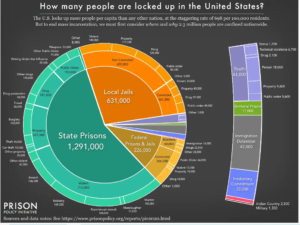The Bail Bond System: A Modern Trap in The Criminal Justice System
There are 8 million people are awaiting trial without a conviction! I repeat, 8 million people are awaiting trial without a conviction! For nearly 20 years, jails have housed more pretrial detainees than convicted criminals ³. In 2010 the Bureau of Justice Statistics estimated up to 5 million people were incarcerated but failed to include 8 million additional people awaiting trial². These people remain in jail because they cannot afford bail. As a result, in the United States, the cash bond or bail system contributes to increasing the incarceration rate of Black people and other minority groups.
What is The Cash Bond/ Bail Bond System?
The bail bond system is often used in today’s criminal justice system, which requires someone arrested to pay a cash or money bail to get out of jail pretrial. The purpose of the bail is to have the person facing the charges return to court for their trial. A person must pay either the total amount of their bail amount or 10% of it to a bond agency for release¹. Bond agencies or bondsmen work closely with the courts. How it works is that bail agents guarantee the courts that a defendant will appear during their court proceedings in exchange for collateral from the defendant’s family member or friend if the accused does not appear for trial. Therefore 10% of a person’s total bail amount is collected to the bond agency 4. Don’t get me wrong; bail agencies have played an important role in reducing the number of defendants in jail before their pretrial. The criticism lies in using people’s valuables as collateral and the approach bondsmen use to take custody of a defendant they feel has broken their contract 4. The bail system translates to payment for freedom before being convicted of a crime for defendants of a nonviolent crime. The problem with this system is that it becomes a trap for some defendants from low economic status and underrepresented backgrounds. Essentially it is a trap for the poor because they cannot afford their freedom before court proceedings, and people much wealthier can afford their freedom while preparing for their trial with their attorney.
(double-click on image to enlarge)
How it Works
After an arrest, the arrestee is interviewed via videoconference by Pretrial Service. Pretrial Service collects information about the arrestee’s financial status to see if a person is eligible for a public defender, then suggests a bail amount to the judge. Bail decisions are made based on many factors, including the initial appearance of a person, race, pretrial interview, nature of the crime, previous criminal record, bail guidelines, potential safety risks posed, and the police report to name a few 8. The average bond hearing is 5 minutes with the defendant present 1. Five minutes is a small amount of time to decide what a person must pay to secure their release.
Holes in The System
Given multiple factors taken into consideration, there is a lack of transparency on how each factor is weighted in the judges’ decisions. According to Assefa (2018), judges have broader discretion and little accountability for their decision-making. Thus, racial bias and stereotypes can filter their way into the decision. As a result, Black defendants or defendants with Afrocentric features tend to have higher bail amounts 7. Discrimination and stereotypes find their way into many Black and underrepresented people’s court battles’ decisions. As a result, Blacks are more likely to plead guilty because of the length of time already spent in jail to deal with the fatigue of legal proceedings.
Who is Affected/Impacted?
Not surprisingly, African Americans and people of color face the most challenges in the criminal justice system, especially making bonds. Dark-skinned Black males were two times more likely to be incarcerated than light-skinned blacks or white 7. Also, Hispanics are disadvantaged in the criminal justice system 6. Besides the threat of incarceration before awaiting trial, defendants also face a social cost. For example, detainees face poor labor trajectory or loss of employment, difficulty obtaining housing, and disruption within the family network 9. Also, intimate relationships decline based on the length of time apart from intimate partners .2, 5
“Innocent until proven guilty” is the presumption that a person has the innocence of a crime until there is substantial evidence that they are, in fact, guilty. The cash bond/ bail system ignores this concept
I ask you this, what happens to the presumption of innocence until proven guilty? Why are African Americans and people of color coerced into pleading guilty when they have the right to provide evidence to support their case?
Want to Learn More? Check Out These Articles and Links:
- Assefa, L.S. (2018). Assessing dangerousness amidst racial stereotypes an analysis of the role of racial bias in bond decisions and ideas for reform. The Journal of Criminal Law and Criminology (1973-), Vol. 108 (4), pp. 653-678
- Apel, R. (2016). The effects of jail and prison confinement on cohabitation and marriage. The ANNALS of the American Academy of Political and Social Science, 665(1), 103–126. https://doi.org/10.1177/0002716216629360
- Beattey, R. A., Jr., Matsuura, T., & Jeglic, E. L. (2014). Judicial bond-setting behavior: The perceived nature of the crime may matter more than how serious it is. Psychology, Public Policy, and Law, 20(4), 411–420. https://doi.org/10.1037/law0000020
- Baker, S., Vaughn, M., & Topalli, V. (2008). A review of the powers of bail bond agents and bounty hunters: Exploring legalities and illegalities of quasi-criminal justice officials. Aggression and Violent Behavior, 13(2), 124-130.
- Clayton, G., Vargas-Edmond, T., & Lunsford, T. (2017). The Hidden Cost of Money Bail: How Money Bail Harms Black Women. Harvard Journal of African American Public Policy, 59-66
- Demuth, S. (2003). Racial and ethnic differences in pretrial release decisions and outcomes: A comparison of hispanic, black, and white felony arrestees*. Criminology, 41(3), 873-907. http://dx.doi.org/10.1111/j.1745-9125.2003.tb01007.x
- King, R. D., & Johnson, B. D. (2016). A punishing look: Skin tone and afrocentric features in the halls of justice. American Journal of Sociology, 122(1), 90-124.
- Stevenson, M.T. (2018). Distortion of justice: How the inability to pay bail affects case outcomes, The Journal of Law, Economics, and Organization, 34(4), 511–542, https://doi.org/10.1093/jleo/ewy019
- Wakefield, S., & Andersen, L. H. (2020). Pretrial Detention and the Costs of System Overreach for Employment and Family Life. Sociological Science, 7, 342-366.
- https://www.prisonpolicy.org/reports/pie2020.html

